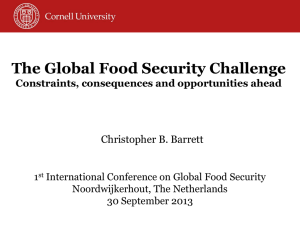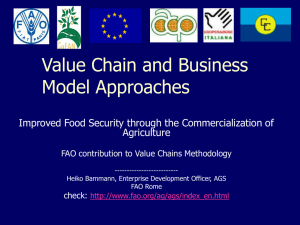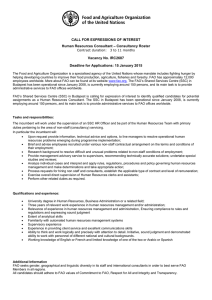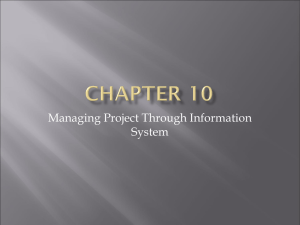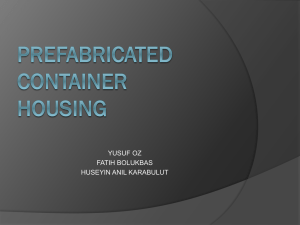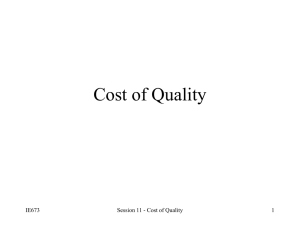FAO specifications (pesticide formulations & relevant impurities)
advertisement
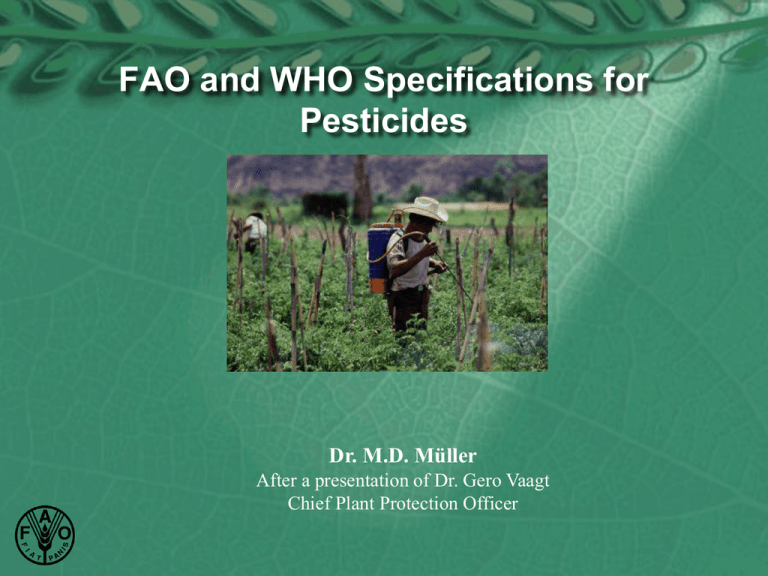
FAO and WHO Specifications for Pesticides Dr. M.D. Müller After a presentation of Dr. Gero Vaagt Chief Plant Protection Officer Specifications are a priority in Plant Production for FAO Voluntary standards to reduce risks with using pesticides To contribute to the improvement in agricultural production while safeguarding applicator safety, health of consumers and protect the environment How are FAO and WHO specifications used? As part of a buyers contract: the garantee that the buyer gets the quality which is achievable As a standard for competent authorities to check whether the quality on the market is that as registered. Specifications are intended to Garantee security of the products By avoiding additional, unforeseen risks to the user, to the consumer of agricultural commodities and to the environment Garantee efficacy maintain quality also after certain storage to avoid fraud, loss of money and . What is the aim of FAO and WHO specifications for pesticides To make sure that the pesticides which comply with the specification provide satisfactory results for the purpose they were developed for and do not show unexpected risks Quality of pesticides Statistics established by FAO and WHO estimate that 30% of pesticides on sale in developing countries are substandard. Also in industrialized countries 25 % of pesticides examined in Belgium, in UK 12 % and in Germany 17 % were of inferior quality Control of Risks A national control of pesticide quality is needed to monitor pesticides on the market Without an adequate control, an even higher proportion of pesticides would have insufficient quality The users have no possibility to check the quality of the pesticides they buy It is the responsibility of the government, of manufacturers and of suppliers to check the quality of pesticide What is a specification? A list of criteria and parameters ...which allows a pesticide quality control laboratory to check and to distinguish between good and bad products of the same type Fundamental properties are not verified …therefore do specifications not relate to the activity of the active ingredient... …nevertheless they assist the user in choosing the right product for his purpose What makes a “good” product Correct appearance Contains the correct amount of active ingredient Contains the minimum of relevant impurities Does have acceptable physical-chemical properties Does keep the correct content, acceptable physical properties upon storage and does not show unacceptable increase of relevant impurities. The FAO Manual on Specifications The 1st Edition of the Manual was published in 1971 and was the basis for 360 specifications “old procedure” The 5th Edition of the Manual in 1999 contains a new procedure for development of specifications, in which the requirements were significantly enlarged. The FAO/WHO Manual on Specifications contd. Today, the 2010 Edition of the FAO/WHO Manual on Specifications is available The FAO/WHO specifications are the basis for the registration of pesticides in the EU, in the countries of Andean Community and in many other The specifications are a source of international harmonization Agricultural pesticides - FAO. Public Health Pesticides: WHO linked with the efficacy testing by WHOPES The manufacturers provide the data package New and old procedure by FAO Prior to 1999, 360 pesticide specifications were published under “old procedure” Since 1999, specifications for more than 140 compounds under the “new procedure” were elaborated and published Main differences between old and new procedure Specifications under the new procedure are applicable only to the material evaluated by the Panel of Experts of FAO and WHO The new procedure defines nevertheless a process, how equivalence with a product of a second manufacturer can be established. Global pesticide market Estimated at $27700 million (2003) Western Europe 20% Eastern Europe 3% North America 30% Far East 26% 26% Latin America 14% Others 7% 7% 20% 3% 14% 30% Pesticide Market in the EU • 20 % of pesticides sold worldwide are used in EU (appr. US dollars 5.6 billion $) • Distribution of pesticides in EU 2002: • Patent protected 27% • Generics 73% • Estimates foresee more than 90 % generics in EU in 2011 Procedure for the development of specifications Industry proposes the inclusion of new or revised specifications into the program. A member of the JMPS is designated as evaluator of the data package. The proposer presents draft specifications with supporting information for a preliminary evaluation for completeness. FAO contacts the registration authorities of the country where the product is registered for a risk assessment. Procedure for the development of specifications (contd.) The evaluator checks whether the data package meets the criterial for an evaluation within JMPS The data on impurity profile are compared to those held by the national authority The JMPS meets one time per year and adopts or rejects the specification The specifications, once adopted, are published together with the evaluation report. The process takes approx. 18 months. Elaboración de las Especificaciones de Plaguicidas para el uso en Agricultura y Salud Pública FIRST PROPOSER SUBSEQUENT PROPOSER DRAFT SPECS AND SUPPORTING DOCUMENTS DRAFT SPECS AND (REDUCED) SUPPORTING DOCUMENTATION FAO/WHO EVALUATION OF DATA JOINT MEETING FOR PESTICIDE SPECIFICATIONS (JMPS) SPECIFICATIONS AND EVAL. FOR TC OR TK EQUIVALENT TO REFERENCE EFFICACY TESTING(WHOPES) PUBLICATION OF SPECS AND EVALUATION FOR WHO – PUBLIC HEALTH NOT EQUIVALENT CORRECTED OR REJECTED SPECIFICATION PUBLICATION OF SPECS AND EVALUATION AGRICULTURAL PESTICIDES FAO FAO/WHO Programme of Specifications Year 2005 Products Proposer(s) FAO Clofentezine TC, SC Chlorothalonil Copper , cupric hydroxide and oxychloride (to include copper calcium oxychloride), Bordeaux mixture, tribasic copper sulphate and cupric oxide Cymoxanil Diquat dibromide, SL Ethofumesate TK,SC,EC,SE,OD Nicosulfuron TC, WG Pendimethalin TC,TK,EC Rimsulfuron TC, WG Makhteshim Caffaro SpA, Vischim Srl, SDS Biotech K.K. European Union Copper Task Force Oxon Syngenta Bayer Dupont Industria Prodotti Chimici Dupont WHO IR3535 Permethrin long-lasting insecticidal net S-bioallethrin TC Permethrin/S-bioallethrin EW Temephos Merck Sumitomo Sumitomo Bayer BASF FAO & WHO Alpha-cypermethrin TC, SC, WP Bendiocarb TC, WP Deltamethrin TC, WP Deltamethrin TC, SC, WT, WG, WP, EC Permethrin TC Permethrin TC, EC Pyriproxyfen TC,GR Spinosad TC,GR,SC BASF, Tagros Agros Agros Tagros Sumitomo Tagros Sumitomo DAS FAO/WHO Programme of Specifications Year 2006 Products Proposer(s) FAO Carbaryl TC, Clodinafop propargyl … Chlorothalonil TC Clofentezine TC, SC Fosetyl-Al TC, WG, WP Propanil TC Propaquizafop TC, EC Bayer Syngenta Sipcam Agro USA, Inc. Makhteshim Bayer Proficol, S.A. Makhteshim WHO Alpha-cypermethrin LN Bacillus thuringiensis israelensis WG, DT Permethrin LN Transflutrin TC BASF Valent BioSciences Sumitomo Bayer FAO & WHO Bendiocarb TC, WP Chlorpyrifos TC, EC, UL Deltamethrin TC Dimethoate TC, EC Etofenprox TC, EW, WP Lambda-cyhalothrin TC, WP rs-Methoprene TC, EC Permethrin TC, EC Argos Cheminova, ACME Org. Herbana Ind. JSC Trans oil, Ukraine Mitsui Tagros Babolna Bio Tagros Development of specifications Description in the FAO/WHO specification Manual, Rome 2010 Accessible through: http://www.fao.org/agriculture/crops/corethemes/theme/pests/pm/jmps/en/ It is not an international registration process WHO uses same procedure. Basis of specifications Formulations are prepared from technical active ingredients (TC or TK). TC/TK specifications are indispensable for the development of formulation specifications. TC/TK specifications are simple - but a lot of data are required to support such a specification A TC/TK SPECIFICATION Identity structure, molecular weight etc. Manufacturing method (confidential data) starting materials, solvents, conditions. Content of active ingredient in the technical material (confidential data) Data in g/kg for five typical batches, including the manufacturing specification A TC/TK SPECIFICATION... (continued) Physical and chemical properties: vapor pressure, melting point, solubility in water etc. Methods used to check the quality (CIPAC Methods!) Toxicology data tox package acute, subchronic and chronic A TC/TK SPECIFICATION... (continued) Ecotoxicology toxicity to fish, Daphnia, algae, birds, etc. Evaluation of risks to be provided by IPCS, JMPR, national authorities These data is evaluated to identify relevant impurities; make sure that all clauses are sufficiently supported; avoid that undue advantage is created by a specification RELEVANT IMPURITIES Are those which can adversely influence toxicological endpoints, or ecotox, phytootoxicity, ecotoxicology, may contaminate crops, may have adverese effect on the stability of the pesticide etc. Water or insolubles may be relevant in certain cases RELEVANT IMPURITIES (contind.) Are limited to such an extent that higher amounts may increase the risk of the pesticide during handling and use. Methods. Peer validated methods are needed to determine the content of these impurities. The maximum permitted concentration is expressed relative to the active ingredient EQUIVALENCE More than one manufacturer of a certain active may exist In most cases, all qualities of a certain active can be controlled with the same specification. In certain cases, a separate specification or a modified specification may be necessary. FAO specification for paraquat, 2003 I FAO specification for paraquat, 2003 II CIPAC method Handbook G CIPAC Methods: on CD ROM or in print, latest is Handbook N EQUIVALENCE DETERMINATION FOLLOWING THE “NEW PROCEDURE” The aim is to determine whether or not: • an existing specification is applicable to the similar product of a second manufacturer • the additional product may give rise to additional dangers or major risks as compared to the product the specification is based upon (not worse...) Who can establish equivalence? • FAO/WHO JMPS or a national authority. • The national registration authorities cannot establish equivalence by laboratory studies… Who can establish equivalence?(contd.) • FAO/WHO cannot judge on national specifications…. • Users of pesticides and manufacturers cannot evaluate equivalence…. • The confidential information is not disclosed to third parties and is rigorously protected. Official liaisons of FAO with other organizations in developing specifications With PCS or JMPR (for ADI and ARfD). "Rotterdam Convention" (PIC). With EU and national authorities With CIPAC, AOAC International, OECD, etc., for methods of analysis and determination of physical properties. Publications FAO - evaluations and specifications : http://www.fao.org/ag/agp/agpp/pesticid/ WHO - evaluations and specifications : en:http://www.who.int/ctd/whopes/ Search by Pesticides: Search Clear Plant Production and Protection Division - Plan Protection Service - Pesticide Management Unit Who we are Mission Staff Welcome to FAO Pesticide Management Pesticide Management is an activity carried out within the overall framework of the Plant Protection Service of FAO. It is designed to work together with member countries as a partner to introduce sustainable and environmentally sound agricultural practices which reduce the health hazard associated with the use of pesticides. Of particular concern are countries where living and working conditions make pesticide use more hazardous. The International Code of Conduct on the Safe Use and Distribution of Pesticides is providing solutions for this particular problem. The environmental and health impact of pesticides is being reduced through the implementation of a number of concrete programmes on pesticide management, including: residue analysis product standards setting and methods to analyze them prevention of accumulation of obsolete stocks of pesticides and means to dispose them exchange of information on national actions taken to control pesticides Search by Pesticides: Search Clear Plant Production and Protection Division - Plan Protection Service - Pesticide Management Unit Programmes International Code of Conduct Maximum Pesticide Residue Levels (MRLs) Pesticide Specifications Prevention/ Disposal of Obsolete Pesticides Prior Informed Consent – Rotterdam Convention (PIC) Management of Pesticides Programmes Welcome to the Plant Protection Service (AGPP) The Plant Protection Service of FAO addresses international aspects of plant protection and closely cooperates with regional and national plant protection organizations and programmes. The programme addresses plant quarantine in the Secretariat to the International Plant Protection Convention, setting standards, exchanging information and fostering cooperation. Concerning pesticide management, the programme promotes the implementation of the International Code of Conduct on the Distribution and Use of Pesticides; it implements with UNEP the PIC procedure on banned and severely restricted pesticides and, with WHO, makes recommendations for maximum residue levels. On Pest Management, the Service supports the establishment of Integrated Pest Management Programmes. including the application of Biological Control and weed management. The Plant Protection programme provides regular updates on the desert locust situation through the Desert Locust Information Service. A forum for countries to discuss and take action on locust management is provided through the Desert Locust Control Committee and several Sub-regional Commissions. The programme also technically supports and coordinates migratory pest control operations, where so required. Through the EMPRES programme, the Service assists in early warning, early reaction and research on pests of a transboundary nature. Initial emphasis is on migratory pests, in particular the strengthening and support of the Desert Locust Management System. A cooperative programme has been developed in the Central Region and is being extended to West Africa. Plant Protection Officers in the regions provide regional, sub-regional and national dimensions to the Programme. Plant Protection posts exist in the Regional Offices in Africa (Ghana), Asia and the Pacific (Thailand), Latin America (Chile), and the Near East (Cairo), and in the sub-regional office in Tunis, Barbados and Western Samoa. A Locust Officer is posted in Algeria. For information Niek Van der Graaff Chief, Plant Protection Service FAO Pesticide Management Pesticide Specifications and Quality Control Standards FAO Specifications for Plant Protection Products FAO Specifications for Plant Protection Products - (based on the old procedure). Based on the old procedure (developed up to 1999), copies available for immediate download (Word 6.0 format or PDF Format) are highlighted and next to the green arrow. FAO Specifications for Plant Protection Products - (following the new procedure). Following the New Procedure (introduced in 1999) copies available for immediate download (PDF - format) are highlighted and next to the brown arrow. Withdrawal of 27 outdated/obsolete pesticide specifications Programme for the development of FAO/WHO Specifications, 2002 - 2006 Status Report of the Development of FAO Specifications Meetings on Pesticide Specifications Call for submission of applications to establish a roster of experts as candidates for membership of the FAO Panel of the JMPS FAO Pesticide Management FAO Specifications for Plant Protection Products New Specifications List |A|B|C|D|E|F|G|H|I|L|M|N|O|P|Q|S|T|V|Z SPECIFICATION YEAR bentazone 1999 bensulfuron-methyl 2002 beta-cyfluthrin 1999 |A|B|C|D|E|F|G|H|I|L|M|N|O|P|Q|S|T|V|Z SPECIFICATION YEAR chlorpyrifos 2002 A|B|C|D|E|F|G|H|I|L|M|N|O|P|Q|S|T|V|Z SPECIFICATION YEAR dazomet 2001 dicamba 2001 Outlook New technologies for control of pests may require new specifications and possibly adapted procedures The evolution of science and technology may lead to different evaluation of risks and risk management. Conclusions FAO and WHO specifications are accepted worldwide and promote the commercialization of good quality pesticides and desencourage that of low quality. The procedures to develop specifications are transparent and sufficiently flexible and the specifications are easily accessible. FAO and WHO cooperate with other organizations like CIPAC to make best use of available resources. Thank you for your attention

